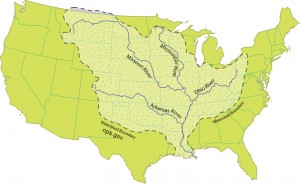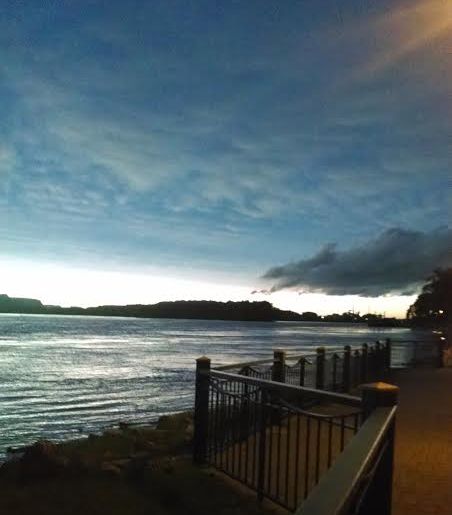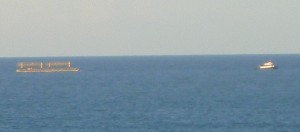Thousands of swans are still tucked into the bays south of Goose Island. A Beautiful weekend, come on out. Look for swans in the rice bed as well as the pools! Enjoy!!
Category Archives: Questions Questions
New Kindle Versions of our Most Popular Steamboat Book…and a Little Something Extra!
If your favorite River Buff has become a Kindle fan, we now have the following NEW Kindle Editions available for Pre-order for Christmas gifting this year!

“Treasure Hunting” has been one of our most requested river topics through the years. Pirates, military trails, payroll caches, old maps and steamboat wrecks have all left tales of sudden death and unrecovered treasures. In the first of our Kindle “INSIGHT Series” we have collected a number of our previously published favorite treasure hunting stories, how-tos, and resources available to the Treasure Prospector here on the upper Mississippi River.
“One Man’s Treasure” is now available for pre-order in the Kindle Store. PRE-ORDER RIGHT HERE, now, just $2.99!

Our ever-popular steamboat anthology, COME HELL OR HIGH WATER by Michael Gillespie is newly available as a quality 2-Volume KINDLE edition. Filled with historic photos, witty commentary, footnotes, bibliography, Glossary and fascinating river facts and stories. Each Volume is purchased separately.
Volume 1 PRE-ORDER RIGHT HERE. $9.95
Volume 2 PRE-ORDER RIGHT HERE. $9.95
Special Pricing our most popular Book and Map RIVER BUNDLE… Great River Road/Mississippi River Guides and SAVE $30!
We’re excited! Great River Arts, our historic map publisher, is gradually taking over our collection of quality Mississippi River and they are making a special offering all four Volumes of Discover! America’s Great River Road and the 1887 “Father of Waters” Historic Reproduction of the full length of the Mississippi River.
This is an opportunity for you to save more than $30 on our most popular Book/Map Art Bundle!
Perfect for Gift Giving! Need extra maps? Everyone who loves our 1887 map by Lisa Middleton will love Discover! America’s Great River Road, our comprehensive guide to life along the river for their favorite section! Just CLICK HERE to purchase additional maps!
All Great River books can be ordered  individually as well. CLICK HERE to go Straight to BOOKS on our new Shopping Cart at Great River Arts.
individually as well. CLICK HERE to go Straight to BOOKS on our new Shopping Cart at Great River Arts.
Let us know if you have any questions!
Monarchs on the Mississippi River!
Bellevue State Park Butterfly Sanctuary
Bellevue State Park, near Bellevue, Iowa, just south of Dubuque, is located atop a 300-foot high limestone bluff with panoramic views of the Mississippi River valley and Lock & Dam 12. It also shelters the largest Butterfly Garden in Iowa.
The Garden Sanctuary for Butterflies near the South Bluff Nature Center in the Nelson Unit contains a variety of interesting displays on the plants, animals and geology of Bellevue State Park.
. This unique area contains over one hundred separate plots, each featuring plants which provide food and habitat for butterflies. A network of pathways allows visitors to walk through the garden and see a wide variety of butterflies as well as enjoy the beautiful array of flowers and the pond in the center. For more information visit the website at Butterfly Garden.

According to the Iowa Department of Natural Resources, butterflies found in Iowa are either in the process of migration or are completing one of the various stages of their life cycle. Approximately 60 species of butterfly can be expected to make their appearance at the Butterfly Garden each year. Host plants for butterflies include wild aster, ragweed, goldenrod, lamb’s-quarters, daisy fleabane, milkweed, cottonwoods, wild cherry, hackberry and willows.
Drainage Map of the Mississippi River and its Tributaries. Some Facts and Figures
QUESTIONS! QUESTIONS!
For Jack, who wants to know more about all the tributaries of the Mississippi River: how many there are, their names, and how long they are!

There are some 250 tributaries of the Mississippi which drain a total area of more than 1,247,000 square miles–one third of the nation’s landmass–extending from the Allegheny Mountains in the east to the Rocky Mountains in the west!
Remember the Mississippi River Flood of 1993? It wasn’t just the Mississippi River flooding that wreaked havoc, it was that all those tributaries flooded as well! At one point, the volume of water flowing past St. Louis was eleven times the volume of Niagara Falls!!
We start here with quick facts on the Mississippi River and several navigable tributaries! Please follow links for a little more depth of historical interest and to see ![]() our collection of hand-painted maps!
our collection of hand-painted maps!
The Mississippi River, from its source at Lake Itasca in Minnesota, to the Gulf of Mexico, is approximately 2,348 miles long. The combined reach of the Missouri-Mississippi Rivers is 3,741 miles–a length exceeded only by the Amazon and Nile rivers. The Mississippi River has shortened by several hundred miles since the days of Mark Twain. Even today it varies 30-50 miles each year.
The widest navigable part of the Mississippi is Lake Pepin, on the Upper Mississippi, where it is approximately 2 miles wide. The average current flows from 1.2 miles per hour nearer Lake Itasca, and about 3 mi per hour nearer New Orleans.
Our Mississippi River Ribbon Map has been a best-selling Gift for many years. Lisa now offers her own custom ribbon map designs of both the OHIO RIVER and the Missouri River. Please click on any map image for more info on the map or the tributary. Or PHONE 888-255-7726 to order any map. Mention you saw it on greatriver.com for a one time 10% discount! Click on map images for more info on the tributaries.
Rail Trespass Law Hearing, Stoddard, WI. Continued.
Marc Schulz of the La Crosse County Conservation Alliance said of the trespass issue, “There is no bigger issue regarding the river.” He added that greatests percentage of fatalities on the railroad happen at designated crossings. Schulz said that, “Young professionals come to western Wisconsin because of its natural resources.” He added that, “This is the people’s land and water.”
John Wetzel representing the Wildlife Federation said, “We need more state oversight. Minnesota has done that. He added that this isn’t just a Mississippi River corridor problem saying there are, “. . .hundreds of places in the state where this is a problem.”
Pat McCabe of De Soto said, “I have property on the other side of the tracks. I will not stop crossing.” He added, “I beg you make them (trains) slow down. Who are you going to call? (if there is an accident.)”
Guy Wolfe of Stoddard representing CARS-Citizens Acting for Rail Safety said, “There is a public trust doctrine law. We have a right to these waters.” He added that he has seen derailed cars on both sides of the tracks on “our property.” He urged people to photograph and report issues with the tracks and rail bridges. He said he feels that after reports about decaying rail bridges the railroad started enforcement of the trespass law. He said after letting the permit to repair the Coon Creek bridge at Stoddard expire, the railroad suddenly worked “24-7” to repair it. Wolf added that at least one bridge still in use along the river was built in 1867. He said, “We can’t afford to let (rail) bridges fail.”
Commissioner Wadhwa replied that, “The new fast act law requires that we put bridge inspection results on websites.”
Kirk Holliday of De Soto said that, “BNSF is making threats to the village sewer.” De Soto’s wastewater treatment plant is across the tracks on the river side. He added, “The government bails them (the railroads) out. They get billions to fix their problems and then they basically hold us hostage.”
Gary Moltert of De Soto told about railroad rolling stock that hauls Bakkum crude and ethanol. He said, “Double hulled tankers are safer. Canada is being very proactive enforcing this. Here investors have $80 to $90K in old tankers and the government allows them six years to replace them with safer cars.”
Commissioner Wadhwa replied, “We can’t do anything, but the feds and USDOT can.” He added that, “New tank cars constructed after 2015 and existing cars must be retrofitted and have an advanced brake system installed.”
Sherry Quamme, representing the Mississippi River Parkway Commission said that, “We’re concerned with Wisconsin issues for eight counties of the Great River Road . . . we want to see that there is legal pedestrian access . . . additional crossings are not the answer because it requires a large capital investment.”
Mike Collins of the La Crosse Snowmobile Alliance said, “We purchased a building across the tracks. We asked the railroad for a recreational crossing. We asked them for $6,000.” The railroad denied the request. Collins added, “They said it’s a safety issue. It’s not. It is straight and level for miles.”
Frank LeMay commented that, “Point of access changes won’t work because the river changes from day to day.”
Joan Wolfe of Stoddard asked about changing Act 179, “What’s the downside? Why wouldn’t the governor want to sign it?”
Senator Schilling said that, Assembly leader Van Wanggaard didn’t bring up the trespass law change proposed by 96th Assembly District representative Lee Nerison in the Assembly because, “Governor Walker would likely veto it and the Republicans in the legislature don’t want to be put in the position of overriding the governor’s veto.”
Phillip Hooker of Victory said that the railroad speed limit is too high. “It should be 45 mph max,” he said.
Monique Hooker of Victory expressed her concern about being able to do river cleanups, “The Friends of Pool 9 need to clean along the Mississippi and on the Wisconsin side. Students and volunteers need access to clean up the river banks. We have to look at the environmental issue and put your money where your mouth is.”
Ralph Knutson of De Soto said, “We need more rail inspections. There is no state accountability – no rail inspectors.” He added that, “The railroad is also interested in having only one person on a train to operate it to save money.”
Commissioner Wadhwa said that, “The federal safety board is taking comments on fewer crew.”
Senator Shilling added, “There is a bill in progress to improve emergency preparedness along the railroad and to train first responders to deal with (railroad) emergencies.”
A larger group attended the 1 PM session at Stoddard. More than half a dozen people said they had received trespassing warnings from BNSF officers. The railroad calls it, “ a public safety education campaign.”
Vernon County Sheriff John Spears asked those who received warnings if the officers were polite and courteous. They all replied, “No.” Spears who supports a compromise, told the Stoddard crowd that his deputies were not enforcing the law. “If anybody gets arrested, they’re not spending a night in my jail. That’s for sure,” he said.
Dick Jensen of Stoddard said, “It’s almost like that railroad track now is a fence.”
Richard Meyer of La Crescent, Minn. ““This whole situation has damaged the state’s reputation and the railroad’s,” he said. “People are furious.”
Mike Widner of Boscobel, “The only folks who will likely obey the laws are hunters, fishers and trappers.”
Stoddard Village President Kevin Gobel said, “The enforcement campaign started soon after rail safety groups and the village complained about the condition of BNSF’s bridges.”
Monarch Butterflies Migrate Along the Mississippi River…Destination, Mexico!
Bellevue State Park Butterfly Sanctuary |
| Information: The El Rosario Sanctuary is accessible from either Angangueo or Ocampo. Angangueo is approximately 115 kilometers from Morelia and 205 kilometers from Mexico City.
When to Go: August through October |
|
Flood impact is “noticeable” but not traumatic!!
OK, as happens almost every year, folks are starting to call about flood conditions along the Upper Mississippi River. Especially with 4th of July holiday around the bend! The image here shows Riverside Park in La Crosse, WI. Basically, the river is plum full and about to start climbing onto the sidewalk. (Thank you Laura Smanski!)
I heard from Davenport, IA, that, yes the riverside has water creeping in, but scheduled events have simply been moved to Higher Ground. Since many campsites along the upper Mississippi River can be impacted by high water, you might want to make a phone call. If sites are available, your reserved site might be moved slightly to higher ground.
 Boating of any type is more hazardous in high water. There is lots of debris, including whole trees, flowing by at a mighty quick pace. Canoes and kayaks are not recommended until the river is back to a 6′ stage, rather than the 13+- it is right now. Common Sense is King in high water. Highways, river towns, the Great River Road…not so much to worry about.
Boating of any type is more hazardous in high water. There is lots of debris, including whole trees, flowing by at a mighty quick pace. Canoes and kayaks are not recommended until the river is back to a 6′ stage, rather than the 13+- it is right now. Common Sense is King in high water. Highways, river towns, the Great River Road…not so much to worry about.
Fascinating Cargo–What is it??
 My American Queen friends from the early November Upper Mississippi River cruise will recognize this heavy piece of tubular, yellow striped cargo. We first saw it on a single barge being pushed down the Mississippi River south of La Crosse, WI.
My American Queen friends from the early November Upper Mississippi River cruise will recognize this heavy piece of tubular, yellow striped cargo. We first saw it on a single barge being pushed down the Mississippi River south of La Crosse, WI.
Had no idea then what it was… still have no idea, but I recently saw it again!! …being towed by a tug down the East Coast of Florida off St. Lucie County. Would love to hear from someone what it is. It is exceptionally unusual to have seen it on the Upper Mississippi, and amazing to me that I have now seen it a second time. Anyone have any idea at all??
“Toots” remembers the Delta Queen
“Toots” Maloy, who for some 30+ years was the “face” of the Delta Queen and Mississippi Queen recently sent me her new memoir of her days on the paddlewheelers.
I found it doubly interesting because it was NOT a history of the company, but truly a memoir of her days on the boats, recounted as she made the last river journey of the Delta Queen to its current Tennessee berth.
Toots also serves as our eyes and ears as she gets a last look at the mold-infested shell of the Mississippi Queen. All of us who loved traveling the Delta Queen fleet, who loved traveling with Riverlorians “Toots”, Bill Wiemuth, and the rest of the crew, will find this a poignant reminder of how much has been lost with the cruising paddlewheelers.

“We haven’t just lost a vessel,” Toots writes, “we lost a way of life. And with just a stroke of a pen it could have been saved.”
Yes, we have Toot’s book available online at our Mississippi River bookstore. Just $7 plus shipping for a limited time. 54 pages, with 8 pages of photos.
Please click on the link below to order instantly online, or phone 888-255-7726.
A Page Out of History
by Riverlorian, Karen “Toots” Maloy
As of 2012, the AMERICAN QUEEN will be BACK on American rivers! Click link to see the update.





